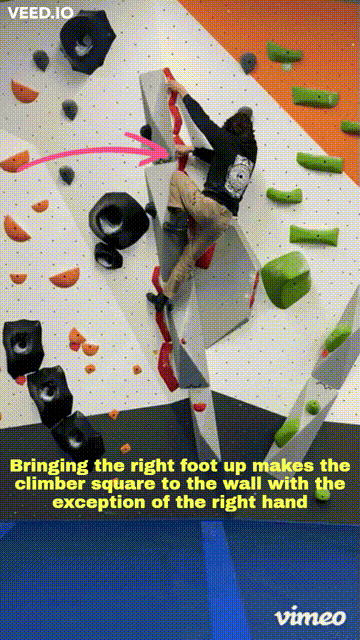Breakdown
Climber: Henry Fernberger 5’11/+0
Wall angle: 5° Overhang
Holds: Cheeta Boomerangs, Teknik No Shadow Tip Toes, MW Volumes
RIC: Risk 1, Intensity 4, Complexity 3
The assignment for this boulder was to create a high-difficulty boulder using the set of red Boomerang holds and the grey volumes. This was accomplished by encouraging multiple movements in a small space via weight shifting and technical foot placement to highlight intensity and complexity. Risk is ranked low on this boulder because there is only one definitive “committing” movement at the end.
Influence/Aesthetic:
This climb started from an aesthetic standpoint, as opposed to being based with movement in mind. The volumes were lined up to accentuate the small corner on the wall, while the holds were used to fill the empty space between the volumes. Connecting these elements creates a visual unity when observing the boulder but also challenges the user when formulating their approach.
Hold Selection:
For this boulder, I wanted to use simple holds in a complex way. Although the holds have one small surface area to grab, they can be placed in ways that require specific body positioning to hold. This is emphasized by placing them in hyper-directional ways opposing difficult foot placements on volumes. If the climber is unable to maintain the tension between these two points, this will likely result in a fall.
Starting Shuffle
Henry begins with all of his weight shifted left due to the rightward direction of the holds and the placement of his right foot.
He works up the row of 3 crimps to begin shifting his weight above his right foot, allowing him to begin moving to the other side of the volumes.
Creating opposition on the large 4th hold with his right hand allows him to stand up and shift his weight rightwards to move his hand down to the farther crimps.
Swaps and Shifts
Once Henry gains the far right hand, his weight begins to be pulled over his right foot; this causes him to swap feet to stabilize.
Now that he is completely rightwards of the volumes, he can move back into the larger hold with his left hand because he can now oppose it with his feet.
Creating Opposition
Henry begins this sequence by bumping off the large feature to a higher, more incut hold. This allows him to begin walking his feet up to gain opposition.
He moves his left foot as high as he can to create the greatest amount of opposition between his left hand and foot.
His right foot stays lower to keep his weight centered on the volumes, which frees his right hand to move higher.
Maintaing Position
Due to the orientation and distance of the last two holds, Henry removes his right foot to gain height and keep his weight centered.
Once the last left hand is gained, his body is extended enough to open his hips and begin bringing his foot up to the side of the middle volume.
Taking the Top
Henry’s high right foot placement puts his body square with the wall; however, his right hand is still pulling him leftwards.
At the time of releasing his right hand, Henry also begins to generate momentum through his legs, letting him hop to the top of the wall.
Final Thoughts
Creating conceptual boulders is a challenging task. I wasn’t sure if this boulder would work functionally, but wanted to make something visually striking. This puts a higher emphasis on the forerunning and tweaking process because there is a chance movements don’t work at all. This makes communication and teamwork paramount during testing. Albeit difficult to create, conceptual boulders can propose stimulating and unique situations for both routesetters and members.





